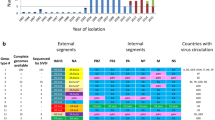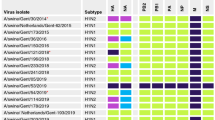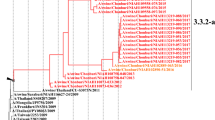Abstract
A swine influenza survey was conducted between 2003 and 2015 in Germany. During this period, 8122 snout swabs or other respiratory specimens from pigs of 5178 herds, mainly from Germany, were investigated for the presence of swine influenza A virus (S-IAV). In total, 1310 S-IAV isolates were collected. Of this collection, the complete genome of 267 H1N2 S-IAV isolates was sequenced and phylogenetically analyzed. The data demonstrate the incursion of human-like swine H1N2 viruses (Gent/1999-like) in 2000 and prevalent circulation until 2010. From 2008 onward, a sustained and broad change of the genetic constellation of the swine H1N2 subtype commenced. The Gent/1999-like swine H1N2 viruses ceased and several new swine H1N2 reassortants emerged and became prevalent in Germany. Of these, the upsurge of the Diepholz/2008-like, Emmelsbuell/2009-like and Papenburg/2010-like viruses is notable. The data reveal the importance of reassortment events in S-IAV evolution. The strong circulation of S-IAV of different lineages in the swine population throughout the year underlines that pigs are important reservoir hosts.




Similar content being viewed by others
References
McCauley JW, Hongo S, Kaverin NV, Kochs G, Lanb RA, Matrosovich MN, Perez DR, Palese P, Presti RM, Rimstad E, Smith GJD (2012) Family Orthomyxoviridae. In: King AMQ, Adams MJ, Carstens EB, Lefkowitz EJ (eds) Virus Taxonomy. Ninth Report of the International Committee on Taxonomy of Viruses. Elsevier Academic Press, Amsterdam, pp 749–761
Zell R, Scholtissek C, Ludwig S (2013) Genetics, evolution, and the zoonotic capacity of European swine influenza viruses. Curr Top Microbiol Immunol 370:29–55
Wu Y, Wu Y, Tefsen B, Shi Y, Gao GF (2014) Bat-derived influenza-like viruses H17N10 and H18N11. Trends Microbiol 22:183–191
Webster RG, Bean WJ, Gorman WT, Chambers TM, Kawaoka Y (1992) Evolution and ecology of influenza A viruses. Microbiol Rev 56(1):152–179
Lu G, Rowley T, Garten R, Donis RO (2007) FluGenome: a web tool for genotyping influenza A virus. Nucl Acids Res 35:W275–W279
Zhou NN, Senne DA, Landgraf JS, Swenson SL, Erickson G, Rossow K, Liu L, Yoon KJ, Krauss S, Webster RG (1999) Genetic reassortment of avian, swine, and human influenza A viruses in American pigs. J Virol 73:8851–8856
Olsen CW (2002) The emergence of novel swine influenza viruses in North America. Virus Res 85:199–210
Brown IH, Harris PA, McCauley JW, Alexander DJ (1998) Multiple genetic reassortment of avian and human influenza A viruses in European pigs, resulting in the emergence of an H1N2 virus of novel genotype. J Gen Virol 79:2947–2955
Van Reeth K, Brown IH, Pensaert M (2000) Isolations of H1N2 influenza A virus from pigs in Belgium. Vet Rec 146:588–589
Schrader C, Suss J (2003) Genetic characterization of a porcine H1N2 influenza virus strain isolated in Germany. Intervirology 46:66–70
Garten RJ, Davis CT, Russell CA, Shu B, Lindstrom S, Balish A, Sessions WM, Xu X, Skepner E, Deyde V, Okomo-Adhiambo M, Gubareva L, Barnes J, Smith CB, Emery SL, Hillman MJ, Rivailler P, Smagala J, de Graaf M, Burke DF, Foucher RAM, Pappas C, Alpuche-Aranda CM, Lopez-Gatell H, Olivera H, Lopez I, Myers CA, Faix D, Blair PJ, Yu C, Keene KM, Dotson PD Jr, Boxrud D, Sambol AR, Abid SH, St George K, Bannerman T, Moore AL, Stringer DJ, Blevins P, Demmler-Harrison GJ, Ginsberg M, Kriner P, Waterman S, Smole S, Guevara HF, Belongia EA, Clark PA, Beatrice ST, Donis R, Katz J, Finelli L, Bridges CB, Shaw M, Jernigan DB, Uyeki TM, Smith DJ, Klimov AI, Cox N (2009) Antigenic and genetic characterization of swine-origin 2009 A(H1N1) influenza viruses circulating in humans. Science 325:197–201
Smith GJD, Vijaykrishna D, Bahl J, Lycett SJ, Worobey M, Pybus OG, Ma SK, Cheung CL, Raghwani J, Bhatt S, Peiris JSM, Guan Y, Rambaut A (2009) Origins and evolutionary genomics of the 2009 swine-origin H1N1 influenza A epidemic. Nature 459:1122–1125
Moreno A, Di Trani L, Alborali L, Vaccari G, Barbieri I, Falcone E, Sozzi E, Puzelli S, Ferri G, Cordioli P (2010) First pandemic H1N1 outbreak from a pig farm in Italy. Open Virol J 4:52–56
Vijaykrishna D, Poon LLM, Zhu HC, Ma SK, Li OTW, Cheung CL, Smith GJD, Peiris JSM, Guan Y (2010) Reassortment of pandemic H1N1/2009 influenza A virus in swine. Science 328:1529
Welsh MD, Baird PM, Guelbenzu-Gonzalo MP, Hanna A, Reid SM, Essen S, Russell C, Thomas S, Barrass L, McNeilly F, McKillen J, Todd D, Harkin V, McDowell S, Choudhury B, Irvine RM, Borobia J, Grant J, Brown IH (2010) Initial incursion of pandemic (H1N1) 2009 influenza A virus into European pigs. Vet Rec 166:642–645
Ducatez MF, Hause B, Stigger-Rosser E, Darnell D, Corzo C, Juleen K, Simonson R, Brockwell-Staats C, Rubrum A, Wang D, Webb A, Crumpton JC, Lowe J, Gramer M, Webby RJ (2011) Multiple reassortment between pandemic (H1N1) 2009 and endemic influenza viruses in pigs, United States. Emerg Infect Dis 17:1624–1629
Hoen SC, Strugnell BW, Russell C, Barrass L, Reid SM, Brown IH (2011) Reassortant pandemic (H1N1) 2009 virus in pigs, United Kingdom. Emerg Infect Dis 17(6):1049–1052
Moreno A, Di Trani L, Faccini S, Vaccari G, Nigrelli D, Boniotti MB, Falcone E, Boni A, Chiapponi C, Sozzi E, Cordioli P (2011) Novel H1N2 swine influenza reassortant strain in pigs derived from the pandemic H1N1/2009 virus. Vet Microbiol 149:472–477
Starick E, Lange E, Fereidouni S, Bunzenthal C, Höveler R, Kuczka A, Grosse Beilage E, Hamann HP, Klingelhöfer I, Steinhauer D, Vahlenkamp T, Beer M, Harder T (2011) Reassorted pandemic (H1N1) 2009 influenza A viruses discovered from pigs in Germany. J Gen Virol 92:1184–1188
Liang H, Lam TTY, Fan X, Chen X, Zeng Y, Zhou J, Duan L, Tse M, Chan CH, Li L, Leung TY, Yip CH, Cheung CL, Zhou B, Smith DK, Poon LLM, Peiris M, Guan Y, Zhu H (2014) Expansion of genotypic diversity and establishment of 2009 H1N1 pandemic-origin internal genes in pigs in China. J Virol 88:19864–19874
Lange J, Groth M, Schlegel M, Krumbholz A, Wieczorek K, Ulrich R, Köppen S, Schulz K, Appl D, Selbitz HJ, Sauerbrei A, Platzer M, Zell R, Dürrwald R (2013) Reassortment of the pandemic (H1N1) 2009 virus and establishment of a novel porcine H1N2 influenza virus lineage in Germany. Vet Microbiol 167:345–356
Zell R, Bergmann S, Krumbholz A, Wutzler P, Dürrwald R (2008) Ongoing evolution of swine influenza viruses: a novel reassortant. Arch Virol 153:2085–2092
Zell R, Motzke S, Krumbholz A, Wutzler P, Herwig V, Dürrwald R (2008) Novel reassortant of swine influenza H1N2 virus in Germany. J Gen Virol 89:271–276
Krumbholz A, Schmidtke M, Bergmann S, Motzke S, Bauer K, Stech J, Dürrwald R, Wutzler P, Zell R (2009) High prevalence of amantadine resistance among circulating European porcine influenza A viruses. J Gen Virol 90:900–908
Lange J, Groth M, Kanrai P, Pleschka S, Scholtissek C, Dürrwald R, Platzer M, Sauerbrei A, Zell R (2014) Circulation of classical swine influenza virus in Europe between the wars? Arch Virol 159:1467–1473
Stech J, Stech O, Herwig A, Altmeppen H, Hundt J, Gohrbandt S, Kreibich A, Weber S, Klenk HD, Mettenleiter TC (2008) Rapid and reliable universal cloning of influenza A virus genes by target-primed plasmid amplification. Nucl Acids Res 36:e139
Groth M, Lange J, Kanrai P, Pleschka S, Scholtissek C, Krumbholz A, Platzer M, Sauerbrei A, Zell R (2014) The genome of an influenza virus from a pilot whale: Relation to influenza viruses of gulls and marine mammals. Infect Genet Evol 24:183–186
Tamura K, Peterson D, Peterson N (2011) MEGA5: molecular evolutionary genetics analysis using maximum likelihood, evolutionary distance, and maximum parsimony methods. Mol Biol Evol 28:2731–2739
Ronquist F, Huelsenbeck JP (2003) MrBayes 3: Bayesian phylogenetic inference under mixed models. Bioinformatics 19:1572–1574
Drummond AJ, Suchard MA, Xie D, Rambaut A (2012) Bayesian phylogenetics with BEAUTi and the BEAST 1.7. Mol Biol Evol 29:1969–1973
Rozas J, Sanches-DelBarrio JC, Messeguer X, Rozas R (2003) DnaSP, DNA polymorphism analyses by the coalescent and other methods. Bioinformatics 19:2496–2497
Anderson TK, Macken CA, Lewis NS, Scheuermann RH, Van Reeth K, Brown IH, Swenson SL, Simon G, Saito T, Berhane Y, Ciacci-Zanella J, Pereda A, Davis CT, Donis RO, Webby RJ, Vincent AL (2016) A phylogeny-based global nomenclature system and automated annotation tool for H1 hemagglutinin genes from swine influenza A viruses. mSphere 1(6):e00275–16
Watson SJ, Langat P, Reid SM, Lam TTY, Cotten M, Kelly M, Van Reeth K, Qiu Y, Simon G, Bonin E, Foni E, Chiapponi C, Larsen L, Hjulsager C, Markowska-Daniel I, Urbaniak K, Dürrwald R, Schlegel M, Huovilainen A, Davidson I, Dan A, Loeffen W, Edwards S, Bublot M, Vila T, Maldonado J, Valls L, ESNIP3 Consortium, Brown IH, Pybus OG, Kellam P (2015) Molecular epidemiology and evolution of influenza viruses circulating within European swine between 2009 and 2013. J Virol 89(19):9920–9931
Moreno A, Chiapponi C, Boniotti MB, Sozzi E, Foni E, Barbieri I, Zanoni MG, Faccini S, Lelli D, Cordioli P (2012) Genomic characterization of H1N2 swine influenza viruses in Italy. Vet Microbiol 156(3–4):265–276
Campitelli L, Donatelli I, Foni E, Castrucci MR, Fabiani C, Kawaoka Y, Krauss S, Webster RG (1997) Continued evolution of H1N1 and H3N2 influenza viruses in pigs in Italy. Virology 232:310–318
Harder TC, Grosse Beilage E, Lange E, Meiners C, Döhring S, Pesch S, Noe T, Grund C, Beer M, Starick E (2013) Expanded cocirculation of stable subtypes, emerging lineages, and new sporadic reassortants of porcine influenza viruses in swine populations in Northwest Germany. J Virol 87(19):10460–10476
Krumbholz A, Philipps A, Oehring H, Schwarzer K, Eitner A, Wutzler P, Zell R (2011) Current knowledge on PB1-F2 of influenza A viruses. Med Microbiol Immunol 200:69–75
Bálint A, Metreveli G, Widén F, Zohari S, Berg M, Isaksson M, Renström LH, Wallgren P, Belák S, Segall T, Kiss I (2009) The first Swedish H1N2 swine influenza virus isolate represents an uncommon reassortant. Virol J 6:180
Metreveli G, Emmoth E, Zohari S, Bálint A, Widén F, Muradrasoli S, Wallgren P, Belák S, Leblanc N, Berg M, Kiss I (2011) Comparison of two H1N2 swine influenza A viruses from disease outbreaks in pigs in Sweden during 2009 and 2010. Virus Genes 42(2):236–244
Brown IH (2013) History and epidemiology of swine influenza in Europe. Curr Top Microbiol Immunol 370:133–146
Bhatt S, Lam TT, Lycett SJ, Leigh Brown AJ, Bowden TA, Holmes EC, Guan Y, Wood JLN, Brown IH, Kellam P, Combating Swine Influenza Consortium, Pybus OG (2013) The evolutionary dynamics of influenza A virus adaptation to mammalian hosts. Phil Trans R Soc B 368:20120382
Bedford T, Riley S, Barr IG, Broor S, Chadha M, Cox NJ, Daniels RS, Gunasekaran CP, Hurt AC, Kelso A, Klimov A, Lewis NS, Li Y, McCauley JW, Odagiri T, Potdar V, Rambaut A, Shu Y, Skepner E, Smith DJ, Suchard MA, Tashiro M, Wang D, Xu X, Lemey P, Russell CA (2015) Global circulation patterns of seasonal influenza viruses vary with antigenic drift. Nature 523:217–220
Lyons DM, Lauring AS (2018) Mutation and epistasis in influenza virus evolution. Viruses 10:407
Krumbholz A, Lange J, Dürrwald R, Walther M, Müller TH, Kühnel D, Wutzler P, Sauerbrei A, Zell R (2014) Prevalence of antibodies to European porcine influenza viruses in humans living in high pig density areas of Germany. Med Microbiol Immunol 203(1):13–24
Acknowledgements
The authors thank M. Müller, I. Heinze and I. Görlich for technical assistance, and S. Bergmann, S. Motzke and C. Steglich for their contributions. Further, we are indebted to I. Brown, M. Büttner, R. Heckler, L. Larsen, C. Linne-Jonas, I. Markowska-Daniel, S. Pleschka, G. Simon, K. van Reeth, J. Süß, O. Werner and members of FluResearchNet for providing influenza virus isolates, and all veterinarians and swine holders who submitted samples to the partner laboratories.
Funding
This study was funded by the German Federal Ministry of Education and Research within the framework of the FluResearchNet (grant nos. 01KI7142, 01KI07143 awarded to R.Z. and 01KI1006J awarded to R.D.) and by the European Union FP7-INFLUENZA-2010 ESNIP3 programme (grant #259949 awarded to R.D.). The sponsors had no role in study design, data collection and analysis, decision to publish, or preparation of the manuscript.
Author information
Authors and Affiliations
Contributions
R.D. designed surveillance and conducted serological investigations, PCR diagnostics and virus isolation; M.G., A.P., J.L., A.K., R.Z. sequenced virus strains; R.Z. conducted phylogenetic analyses; R.Z., A.K., R.D. drafted the manuscript. All authors read the final manuscript.
Corresponding author
Ethics declarations
Conflict of interest
The authors declare no conflict of interest.
Additional information
Handling Editor: William G. Dundon.
Publisher's Note
Springer Nature remains neutral with regard to jurisdictional claims in published maps and institutional affiliations.
Electronic supplementary material
Below is the link to the electronic supplementary material.
Rights and permissions
About this article
Cite this article
Zell, R., Groth, M., Krumbholz, A. et al. Displacement of the Gent/1999 human-like swine H1N2 influenza A virus lineage by novel H1N2 reassortants in Germany. Arch Virol 165, 55–67 (2020). https://doi.org/10.1007/s00705-019-04457-w
Received:
Accepted:
Published:
Issue Date:
DOI: https://doi.org/10.1007/s00705-019-04457-w




